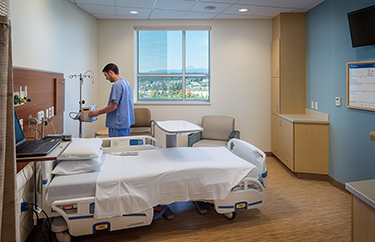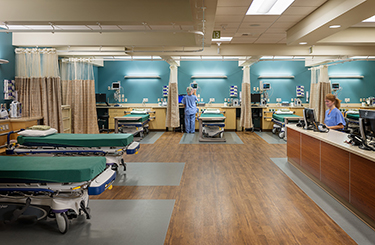|
Subscribe / Renew |
|
|
Contact Us |
|
| ► Subscribe to our Free Weekly Newsletter | |
| home | Welcome, sign in or click here to subscribe. | login |
Construction
| |
 |
July 23, 2015
What we’ve learned about making hospitals better for seniors
Rice Fergus Miller

Miller
|

Gabales
|
Today, seniors represent over 25 percent of the U.S. population, and the percentage will only go up as baby boomers age.
This means one in every four people entering our health care facilities seeking care is a senior. With access to information on how to live healthy, active lifestyles, these seniors are also living longer. These trends have fueled the rise of orthopedic facilities nationwide.
According to the American Academy of Orthopaedic Surgeons, as of the first quarter of 2014, there are at least 2.5 million Americans living with an artificial hip and 4.7 million with an artificial knee. This is a 188 percent increase in knee replacements and 123 percent increase in hip replacements for patients age 45-64.
With advances in technology resulting in quicker stays and faster recovery times, these types of surgeries are on the rise. It is imperative health care facilities, not just orthopedic ones, be designed with seniors in mind.
Rice Fergus Miller is a leading architectural firm in senior living design in Washington state. Two of our current projects, phase two of Timber Ridge at Talus in Issaquah, and Trillium Woods in Plymouth, Minnesota, are in the final stages of construction. Between these two projects are 1.6 million square feet of independent living, assisted living, skilled nursing, acute rehab and memory care.
Rice Fergus Miller also designs health care settings. We are in the early stages of design of a new standalone behavioral health hospital, and are awaiting bids for the construction of Olympic Medical Center’s Medical Office Building and Urgent Care in Port Angeles. Two years ago, we welcomed the first patients to the FHS-Harrison Medical Center’s new 24-bed orthopedics specialty hospital in Silverdale.
Drawn from experience
When designing the Orthopaedic Center at Harrison, our health care team relied heavily on lessons they learned while working on other senior living projects. The team made sure to include the following in the design:
• Safety of movement for the patient and staff. Post-operative patients have a higher risk of slips and falls. This is only heightened for seniors due to their relative lack of strength, lessened in both the upper and lower body musculoskeletal systems.
Getting in and out of bed and safe movement within the patient room are critical to patient safety. Locating the toilet on the head wall allows the patient to reach the toilet room in three easy steps. Continuous handrails, from bedside into the toilet, provide added support to the patient and further minimizes chances of injury.
Zero clearance, no step-over showers are a priority. Adequate space at the wall side of the toilet fixture to allow a two-person assist for toileting is also important. Patient rooms are designed in a way as to allow generous space for equipment, staff and family.
• Senior-friendly color palettes, signage and wayfinding. Eyesight deteriorates with age, and the aging eye lens tends to “yellow,” causing a misperception of colors, especially those in the yellow and red tones, which tend to blur together.
To overcome this, we chose colors using yellow-lens glasses to assure the colors in the hospital would not only be pleasing, but also, where signage is concerned, be readable. Additionally, we chose larger text for signage that is easily readable to older eyes.
Another area of concern for aging eyesight is the misperception of contrast in the floor as a potential step, which when perceived, can cause the patient to misstep and potentially fall. Heavily contrasting colors in the floor should be avoided for this reason.
Contrasting colors and textures were used to give patients additional visual cues, such as in flooring transitions. All text for signage and wayfinding are contrasting, larger and of appropriate color in order to be seen accurately and quickly.
• Accommodations for low dexterity. Hand grabs, rails, door hardware and casework pulls were chosen to be easy to grasp, turn, push or pull.
This allows the elderly patients, as well as staff, to do fine and gross motor operations even with weak muscles or arthritic joints. Where possible, sliding doors are preferable to swinging doors as they are safer to transition through during the operating motion.
With the focus on patient care and positive patient experiences, it is important for health care designers to consider a wide demographic for their facilities. An understanding of how seniors move, behave and even see is critical to successful facility design, be it new construction or a retrofit.
Mike Miller is a senior principal at Rice Fergus Miller. He has been active in the design of senior living and health care facilities nationwide for the past 35 years. Ivi Gabales is a member of the firm’s marketing staff and has over 20 years of design, construction, and marketing experience in several markets.
Other Stories:
- Hospital addition zeroes in on better patient care
- High-tech lights can aid patients by mimicking the effects of nature
- It’s never too early to consider tech in your nursing home project
- Vacant big-box store finds new life as Children’s clinic
- New clinic at Swedish will treat patients who suffer from chronic pain
- Whidbey hospital’s hyper-efficient HVAC system may be the first of its kind here
- How a pharmacy was designed to limit exposure to toxic drugs
- The way we design health care projects is changing in a big way
- Hospice brings comfort to dying patients




